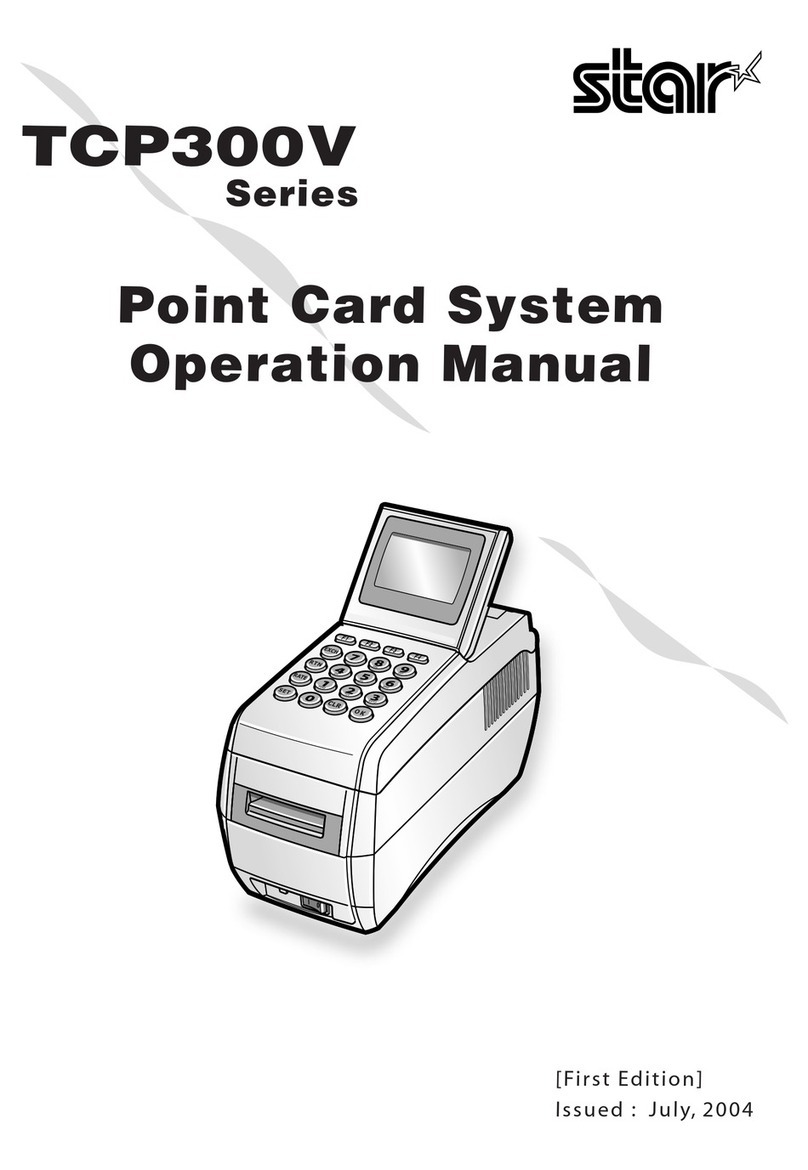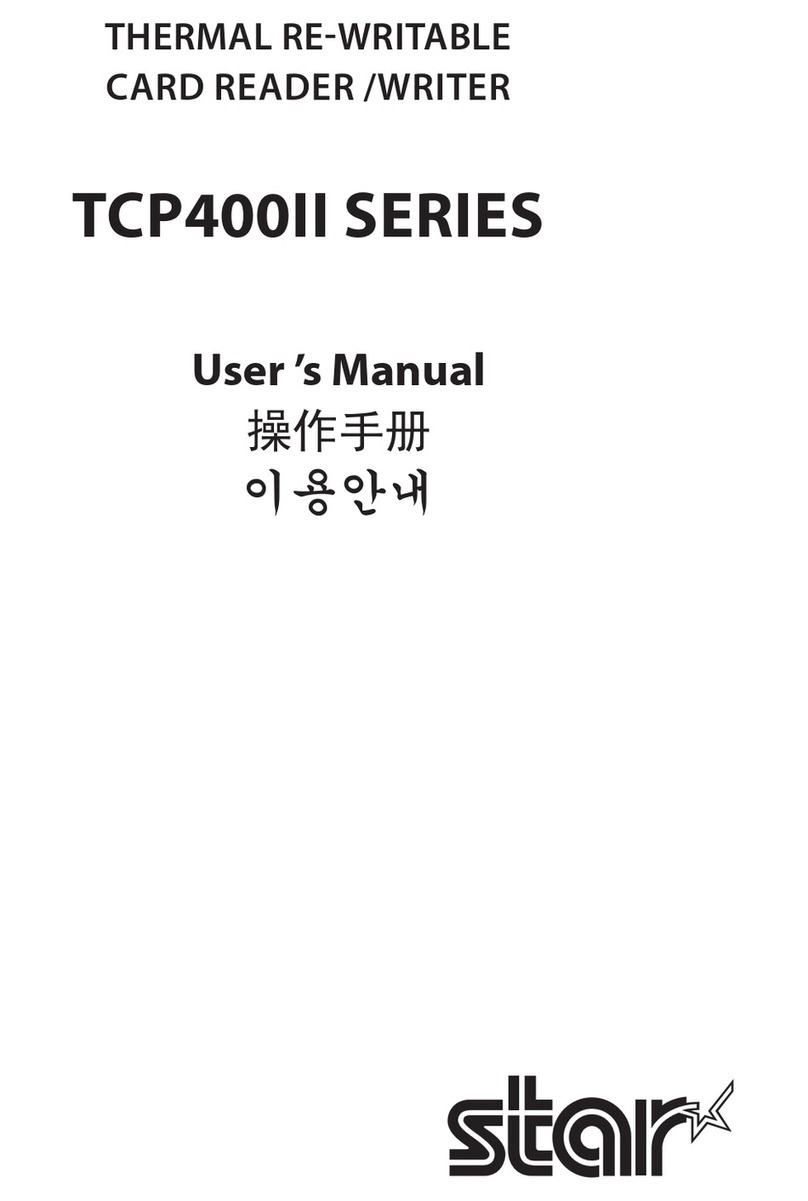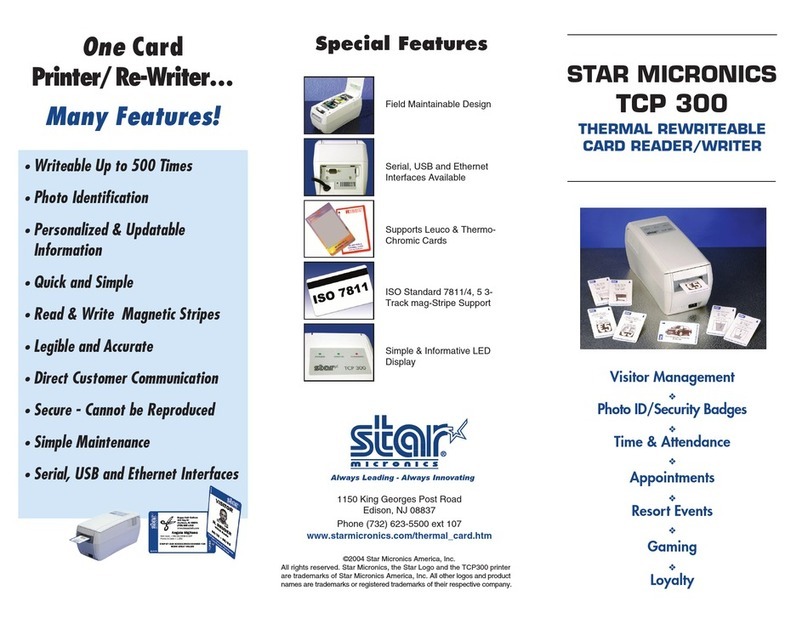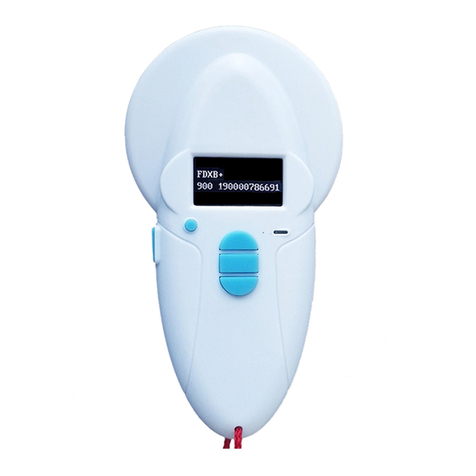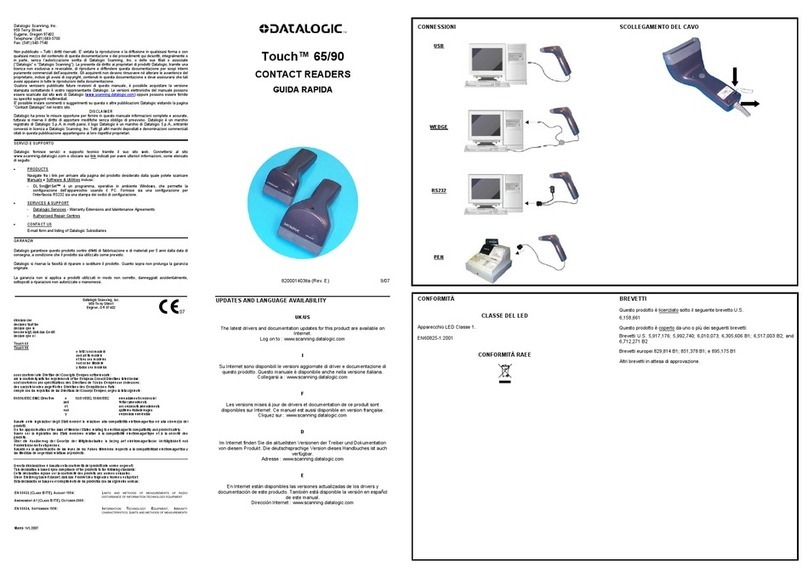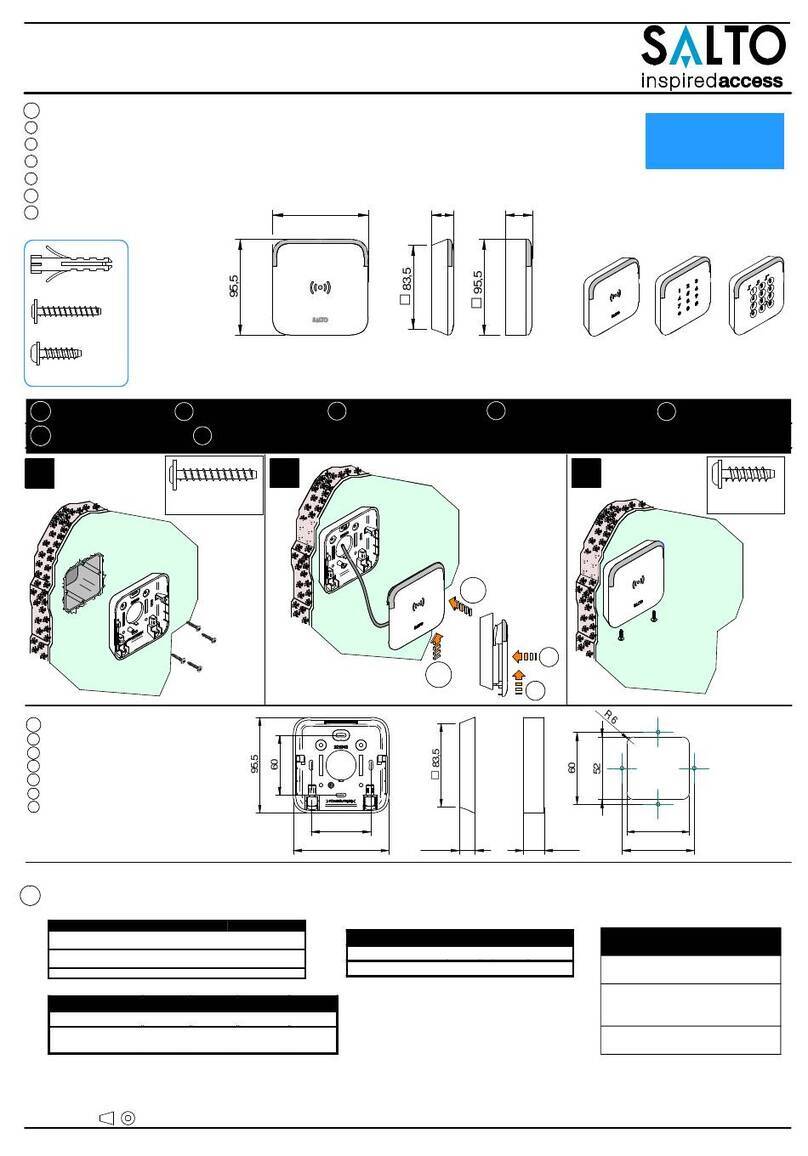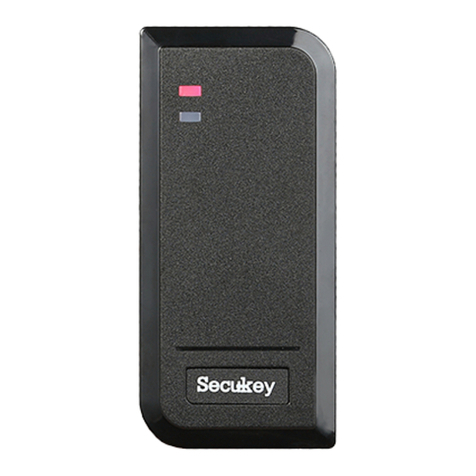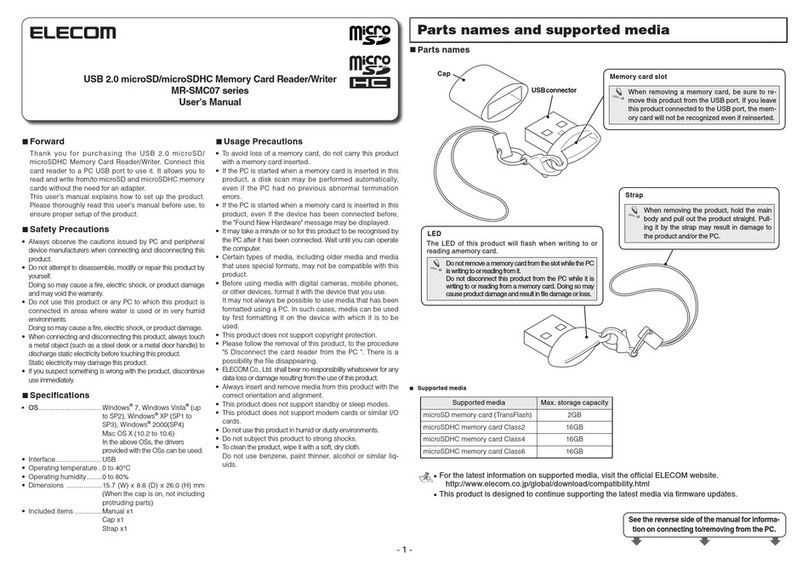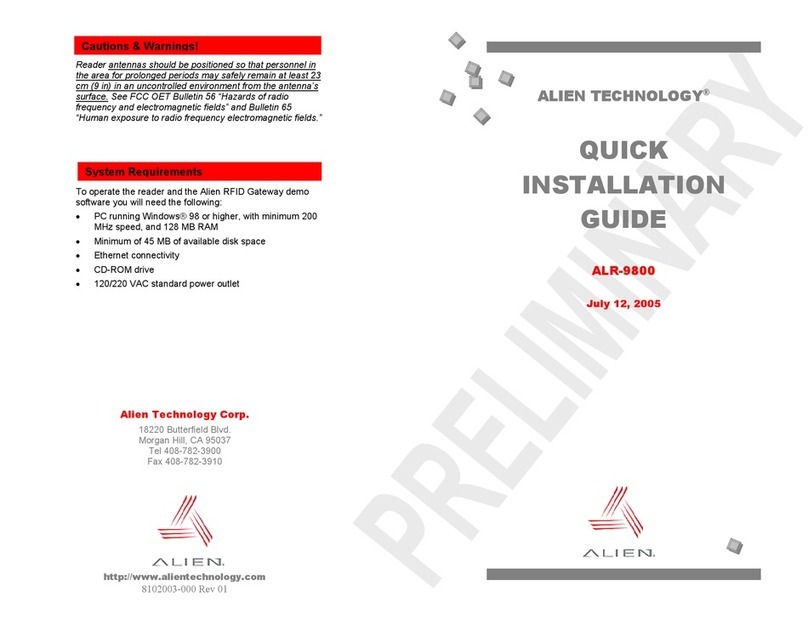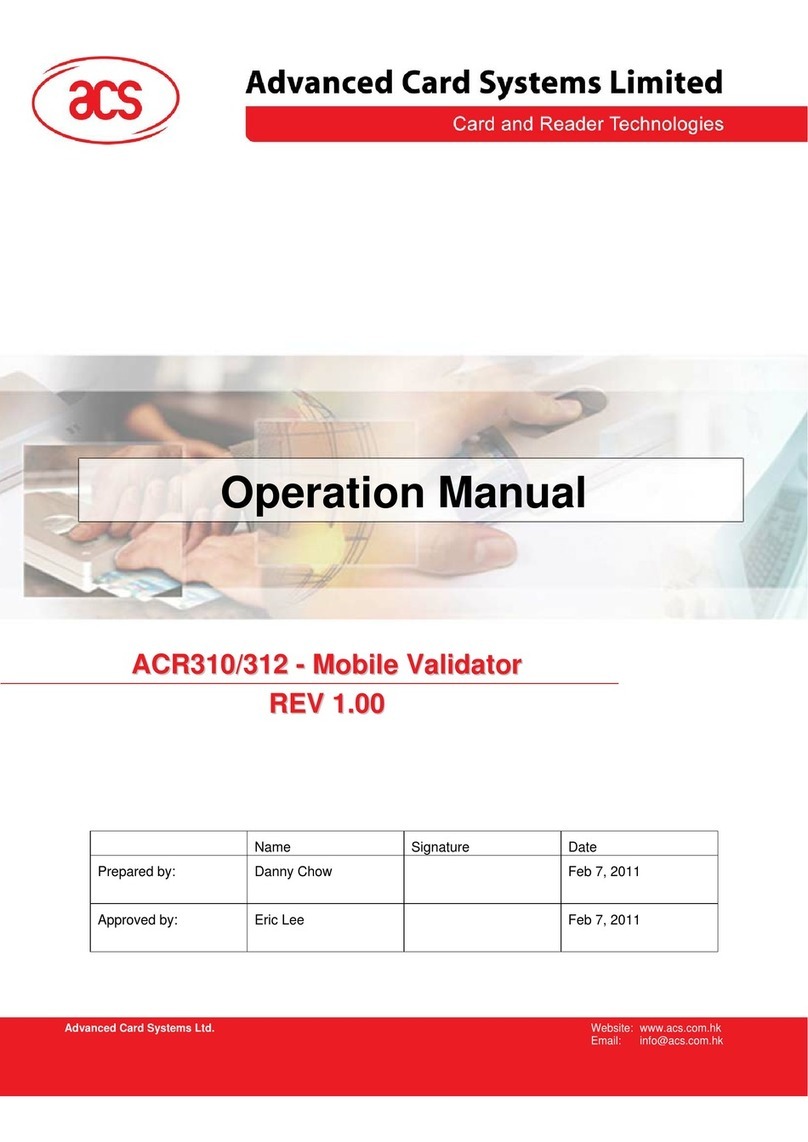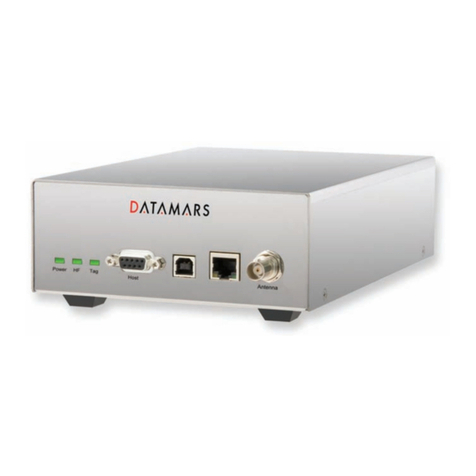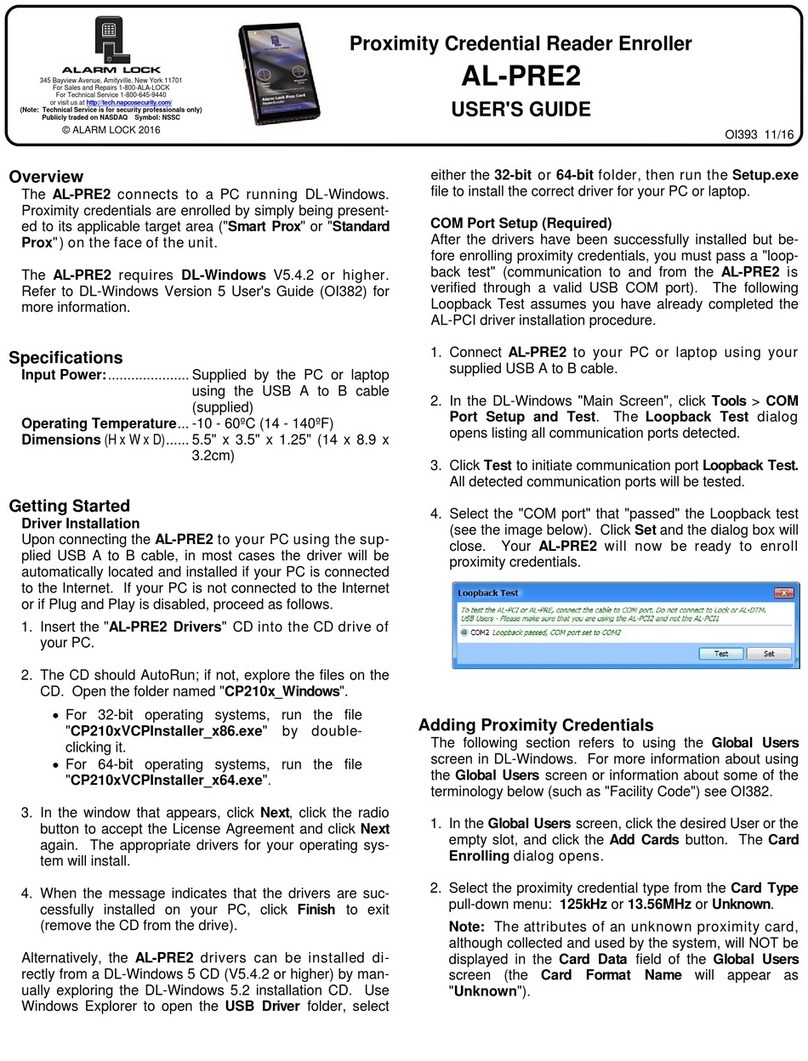Star Micronics TCP300 Series User manual

THERMAL RE-WRITABLE
CARD READER / WRITER
TCP300 SERIES
•
User’s Manual
•
This ‘User’s Manual’ describes important information to enable you to use
the reader/writer safely.
Carefully read this manual before using the reader/writer and observe the
descriptions herein.
CARD SYSTEM SALES SECTION OVERSEAS SUBSIDIARY COMPANIES
STAR MICRONICS CO., LTD. STAR MICRONICS AMERICA, INC.
536 Shimizunanatsushinya, Shizuoka, 1150KingGeorgesPostRoad,Edison,NJ08837-3729U.S.A.
424-0066 Japan Tel: 732-623-5555, Fax: 732-623-5590
Tel: 0543-47-0122, Fax: 0543-48-5013 http://www.starmicronics.com
STAR MICRONICS EUROPE LTD.
Please access the following URL Star House, Peregrine Business Park, Gomm Road,
http://www.star-micronics.co.jp/service/ High Wycombe, Bucks, HP13 7DL, U.K.
frame_sp_car_e.htm Tel: 01494-471111, Fax: 01494-473333
for the lastest revision of the manual. http://www.StarMicronicsEurope.com
2004.12.03
Printed in Japan, 59082067

Federal Communications Commission
Radio Frequency Interference
Statement
This equipment has been tested and found to comply with the limits for a Class A digital device,
pursuant to Part 15 of the FCC Rules. These limits are designed to provide reasonable protection
against harmful interference when the equipment is operated in a commercial environment. This equip-
ment generates, uses and can radiate radio frequency energy and, if not installed and used in accor-
dance with the instruction manual, may cause harmful interference to radio communications. Opera-
tion of this equipment in a residential area is likely to cause harmful interference in which case the user
will be required to correct the interference at his own expense.
For compliance with the Federal Noise Interference Standard, this equipment requires a shielded cable.
This statement will be applied only for the printers marketed in U.S.A.
Statement of
The Canadian Department of Communications
Radio Interference Regulations
This digital apparatus does not exceed the Class A limits for radio noise emissions from digital appa-
ratus set out in the Radio Interference Regulations of the Canadian Department of Communications.
Le présent appareil numérique n’émet pas de bruits radioélectriques dépassant les limites applicables aux
appareils numériques de la classe Aprescrites dans le Règlement sur le brouillage radioélectrique édicté par le
ministère des Communications du Canada.
The above statement applies only to printers marketed in Canada.
CE
Manufacturer’s Declaration of Conformity
EC Council Directive 89/336/EEC of 3 May 1989
This product has been designed and manufactured in accordance with the International Standards
EN 61000-6-3/10.2001 and EN 55024/09.98 following the provisions of the Electro Magnetic Com-
patibility Directive of the European Communities as of May 1989.
EC Council Directive 73/23/EEC and 93/68/EEC of 22 July 1993
This product, has been designed and manufactured in accordance with the International Standards
EN 60950 following the provisions of the Low Voltage Directive of the European Communities as
of July 1993.
The above statement applies only to printers marketed in EU.
TABLE OF CONTENTS
1. recautions for Safe Use ........................................................1
2. General Description ................................................................ 4
3. Unpacking ............................................................................... 5
4. External Appearance and art Names ....................................6
5. Connect to and Setting External Devices ................................ 7
6. Interface Board Replacement (RS-232C to USB) ................. 10
7. Cleaning Cards...................................................................... 11
8. Troubleshooting ..................................................................... 12
9. General Specifications .......................................................... 14

– 1 –
1. Precautions for Safe Use
Carefully read and obey the following items to prevent injury to yourself or to others
and to prevent damaging property.
Precautions for Reader/Writer Setup
1. Setup the reader/writer in a solid, and level location.
2. lace the reader/writer in a location out of the reach of children.
3. Do not use or place the reader/writer in areas exposed to direct sunlight, or near heat
sources.
4. Avoid using or storing the reader/writer in areas of high humidity.
Do not use or store liquids near the reader/writer.
5. Avoid using or storing the reader/writer in locations where there is dust or other air-
borne particles.
6. Avoid using the reader/writer in locations where corrosive gases, ignition gases, chemi-
cals or vapors are emitted.
7. Do not operate the reader/writer near devices which may produce magnetic fields or
interference.
8. Connect the reader/writer to the appropriate, reliable, clean power source.
9. Allow plenty of space around the reader/writer for ventilation.
10. The accessory cleaning liquid is flammable, store it in a cool place, out of sunlight.
11. Avoid contact with the accessory cleaning liquid. If it gets in your eyes, or is ingested,
seek immediate medical assistance.
Always bserve the f ll wing items.

– 2 –
Precautions for Reader/Writer Use
1. Use only Star recommended cards.
The reader/writer and the card may not operate normally if other cards are used.
2. Do not use cards that are dirty or oily or wet in any other manner. Also, do not handle
cards with dirty or wet hands. Do not apply tape or glue to cards.
The reader/writer will not operate normally due to the reason above.
* If the card is dirty, clean the card and the reader/writer.
See section 7. Cleaning Cards for details on how to clean.
3. Do not place cards near devices that generate magnetic fields (such as cellular tele-
phones, speakers, televisions, etc.), as this can erase the information recorded on
cards.
4. Do not place cards in direct sunlight or high temperature areas (such as dashboards
in automobiles), as high temperatures can cause cards to bend or can erase the
information recorded on cards.
5. Do not use bent cards, as this can cause them to become jammed in the reader/
writer.
6. Insert cards in the indicated direction.
Inserting them incorrectly can cause mis-operation or it can erase the information
recorded on cards.
7. Never insert anything other than the appropriate cards into the reader/writer.
8. Do not obstruct the insertion or discharge path of the cards.
Obstruction of these paths can cause reader/writer failure, mis-operation or lead to
injury.
9. Do not cut the power while a card is being processed.
Cutting the power can erase the information recorded on cards.
[TC 300]
(Figure for Reference)

– 3 –
10. In case of reader/writer error (abnormal sounds, abnormal odors, smoke, fire) turn off
the reader/writer immediately and unplug it from the power outlet.
11. Always hold the plug to unplug the power cord from its outlet. ulling on the cord will
damage the cord. Do not pull on the cord. Do not place heavy objects on the power
cord. Do not use power cords that are damaged or frayed. Consult with your sales
outlet.
12. Avoid sudden changes in ambient temperature and humidity.
Allow the reader/writer to sit in its new environment for at least one hour before use.
13. Do not use the reader/writer in an environment where condensation has formed.
14. To ensure reader/writer reliability, clean the reader/writer everyday, or when the cleaning
lamp has lit.
Continuing use without cleaning will cause the reader/writer errors. See section 7.
Cleaning Cards for details on how to clean.
15. Do not disassemble or modify the reader/writer.
16. When cards are excessively dirty:
If cards are dirty or oily, problems can easily occur in reading and writing or cause
missing print and incomplete erasing of information.
* In such cases, clean the card and the reader/writer.
See section 7. Cleaning Cards for details on how to clean.
17. If a card is to be reprinted, allow for at least three minutes between prints.
When printing repeatedly to different cards, no wait is required.

– 4 –
2. General Description
The TC 300 series reader/writers are equipped with a thermal type display mechanism
on a ET( olyethyleneterephtalate) magnetic strip card reader/writer. They are con-
nected to electrical devices such as OS and are used to print/erase characters and
images freely onto the surface of cards.
• Main Features f the TPC300 Series Reader/Writer
1. Reads/writes card magnetic stripe data
2. rints/deletes the card display area
3. RS-232C and USB interface

– 5 –
3. Unpacking
The following outlines the reader/writer and its accessories.
The reader/writer (TC 300 Series)
1. Reader/writer
2. Cleaning cards (2 cards)
3. Cleaning fluid
4. This manual
5. Ferrite core
24
3
5
1

– 6 –
4. External Appearance and Part Names
The reader/writer (TC 300 Series)
1. ower Switch ............................ This turns the power to the reader/writer on and off.
2. ower Indicator Lamp .............. Indicates that reader/writer power is on.
3. Status Indicator Lamp .............. Indicates printer ready, printing and errors.
4. Cleaning Lamp ......................... Indicates the reader/writer needs cleaning.
5. Interface Connector .................. Connects to host computer via a cable.
6. AC Cable .................................. Connects to power source.
7. Cleaning Switch ........................ ress the cleaning switch while turning the power on.
Insert a cleaning card dampened with alcohol to
clean the reader/writer.
6
1
5
4
3
7
2

– 7 –
5. Connect to and Setting External Devices
5-1 RS-232C Interface
<M unting the RS-232C Interface Cable>
1. Cut the power to the host computer and reader/writer.
2. Connect one end of the interface cable to the reader/writer and the other end to the
host computer.
3. Mount the accessory ferrite core to the interface cable.
4. Tighten the left and right screws on the connector.
<RS-232C Serial Interface Cable>
1 Connectors D-Sub 9 IN (Male) * Reader/Writer Side
2 Compatible Connectors D-Sub 9 IN (Female) * Cable Side
3 Connector ins See Table Below
4. I/O Circuit See Table Below
5. Level RS-232C
6. Cable Cross (Reverse) Cable
Pin N . Signal Name I/O Functi ns
1NC
-
Not Connected
2 RXD Input Reception Data
3 XD Output Transmission Data
4 DTR Output Data Terminal Ready
5 GND
-
Ground for Signal
6 DSR Input Data Set Ready (Not Detected)
7 RTS Output Transmission Request
8 CTS Input Transmission Ready (Not Detected)
9NC
-
Not Connected

– 8 –
<Settings f r C mmunicati n Speed>
To change the serial communication settings, change the following DI switch settings.
(Ex-factory Default Settings: DSW 1 to 6 are ON, 7 and 8 are OFF.)
Switches ON OFF
DSW 1-1 Baud Rate Setting (See table below)
DSW 1-2
DSW 1-3 8 bit 7 bit
DSW 1-4 arity Disabled arity Enabled
DSW 1-5 Odd arity Even arity
DSW 1-6 Fixed at On
DSW 1-7 Fixed at Off
DSW 1-8 Fixed at Off
Baud Rates BPS 4800 BPS 9600 BPS 19200 BPS 38400 BPS
DSW 1-1 OFF ON ON OFF
DSW 1-2 ON ON OFF OFF
* If incorrect switch settings are made, there may be a failure of the card reader/writer.
Be careful when making setting changes.
To change the DI switch settings, do the following.
1. Check that the power is turned off for both the reader/writer and the host computer.
2. Remove the two screws.
3. ull out the serial interface card to remove it.
4. Change the DI switch settings on the serial interface card.
5. ush in the serial interface card to mount it.
6. Tighten the two screws.
7. Turn on the power for both the reader/writer and the host computer.
N te: The new settings will take effect when the reader/writer p wer is turned back n.
DI Switches
Other manuals for TCP300 Series
3
Table of contents
Other Star Micronics Card Reader manuals
Popular Card Reader manuals by other brands

ViziT
ViziT RD-4F operating instructions
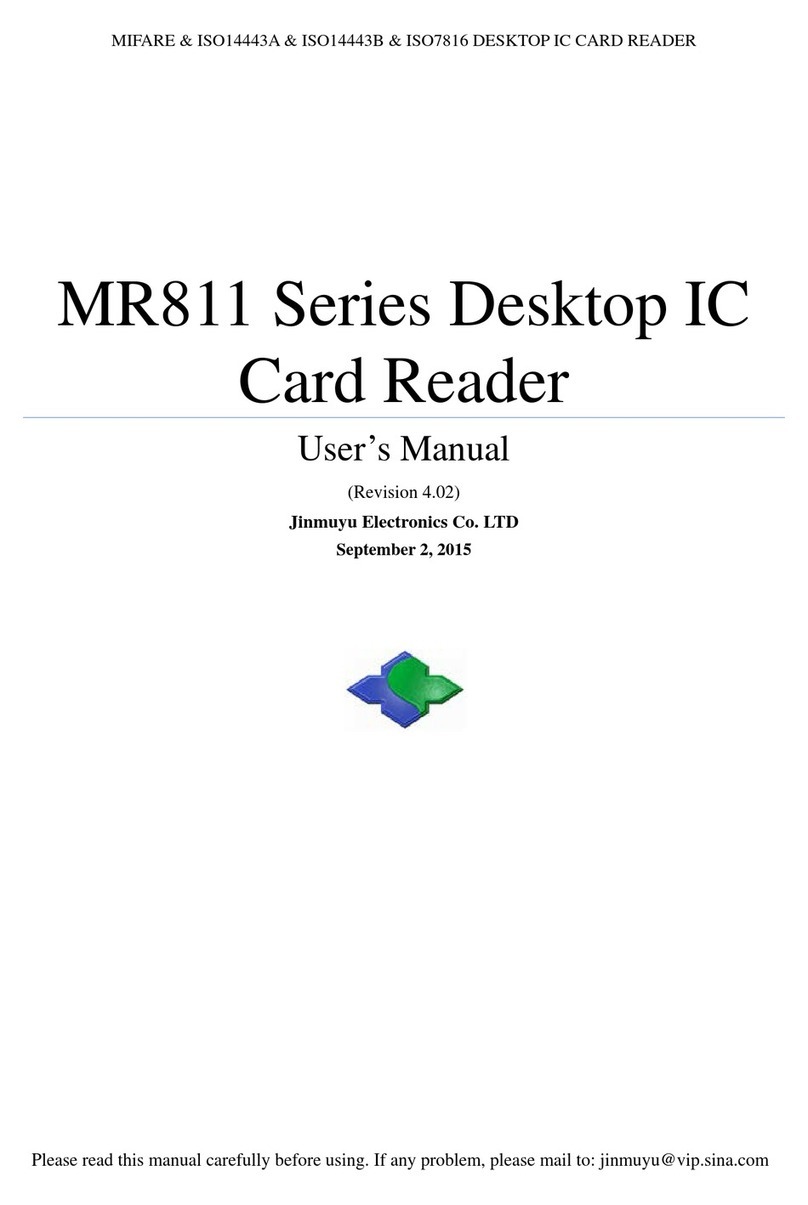
Jinmuyu Electronics
Jinmuyu Electronics MR811 Series user manual

Conrad
Conrad PCMCIA operating instructions

Lindy
Lindy 51541 user manual
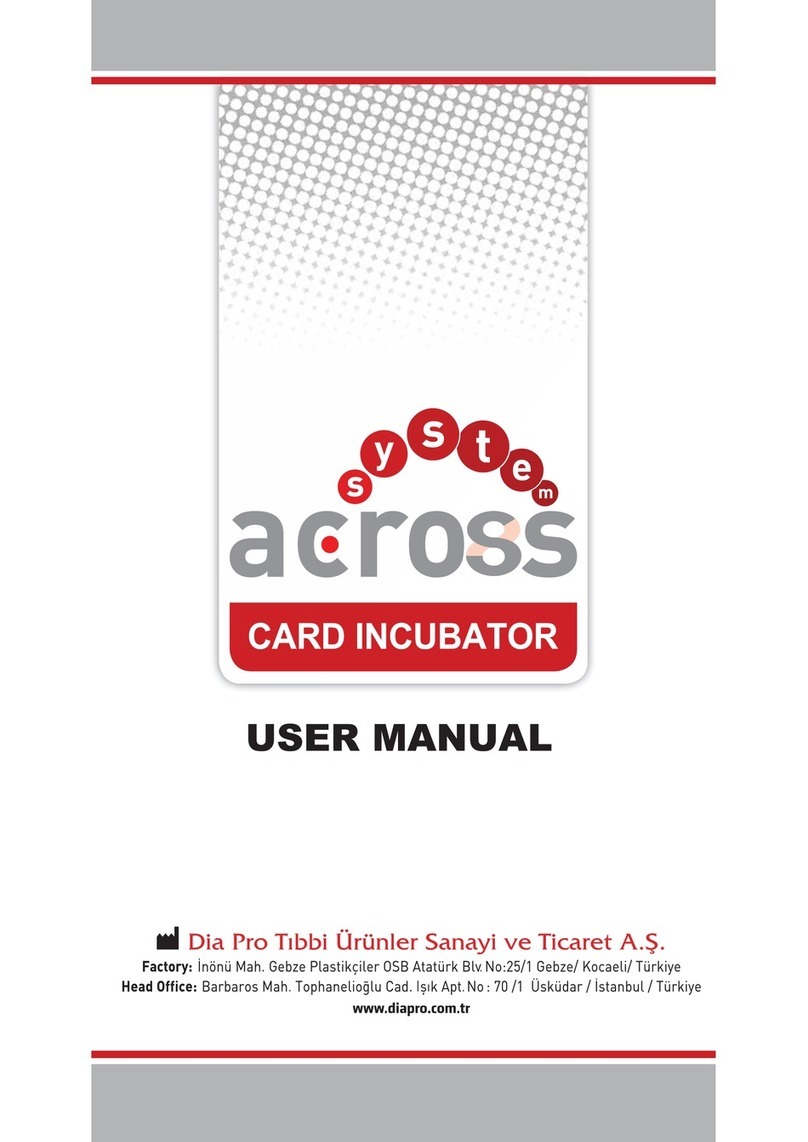
Diapro T?bbi Ürünler
Diapro T?bbi Ürünler Across System user manual
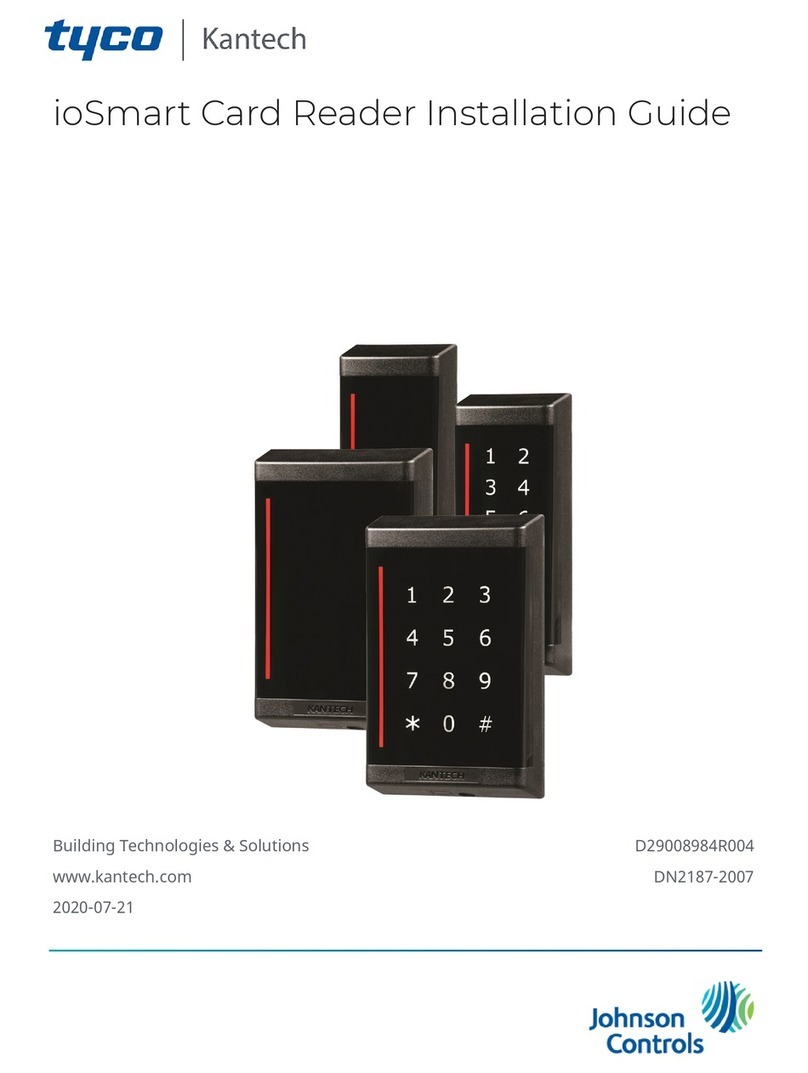
Johnson Controls
Johnson Controls Kantech tyco ioSmart installation guide
